In which Rebecca opens her new sketchbook and dribbles it with strawberry juice.
🍓
Dear Reader,
Jim handed me a parcel to open on our wedding anniversary – a tin, in fact, to mark ten years married.1 I blinked at my discovery of a beautiful handmade sketchbook which Jim had commissioned from a bookbinder he’d met on a photography assignment.
“Look at the cover!” I breathed. The colours were gorgeous… and looked kind of familiar. ‘I gave her a piece of my wedding tweed to refer to!’ he announced. ‘She’s done a perfect job!’
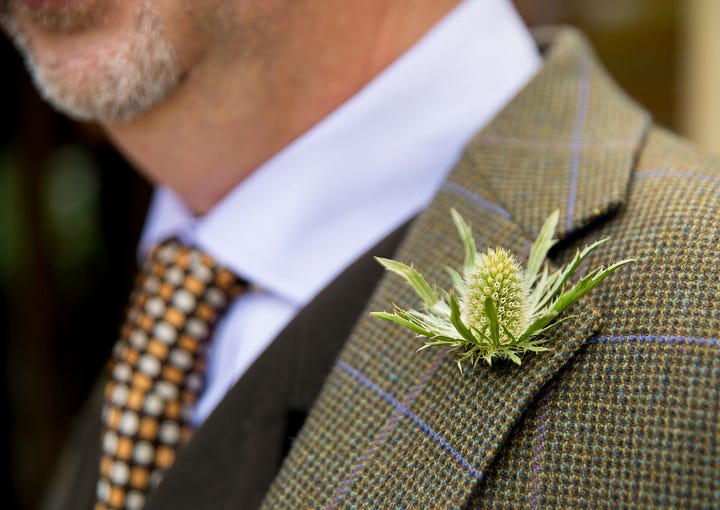
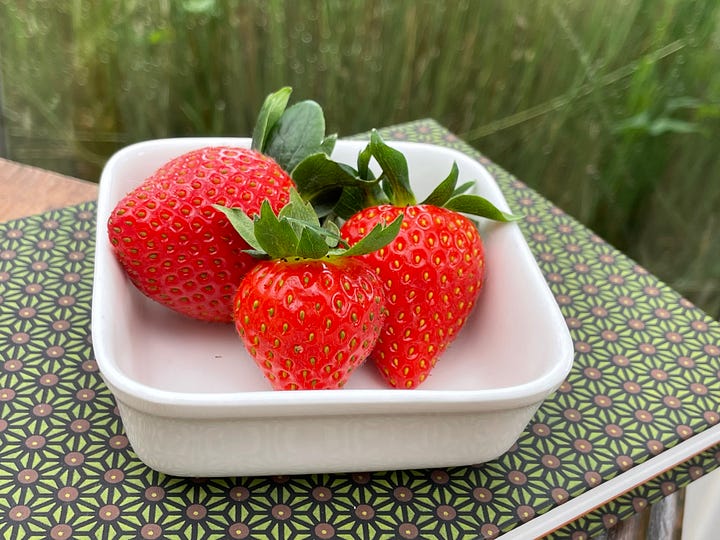
Jim told me that he’d explained to the bookbinder that he wanted a sketchbook which could also stand up to mixed media artwork. ‘I’m not sure we’ve quite got it right, though.’ He was looking anxious. ‘I hope it’s okay…?’
Okay? Reader, it’s perfect. With pages of both drawing paper and canvas, each suitable either for sketching or mixed media, this book is the perfect blend of both requirements. I can’t think of another analogy, but whereas a typical sofa bed tends to be, at best, both an okay-ish bed and and okay-ish sofa, an actual bed and an actual sofa will almost certainly be more comfortable. Neither is having to compromise – but sofa beds, well, those don’t really win in either scenario.
‘You are going to use it!’ Jim told me firmly. ‘I know what you’re like – you get a perfect new notebook or sketchbook, and you tell yourself that they’re too good to use.’ He paused, and began to look anxious. ‘In your last Substack post you were on about arting on scrap paper and in cheap books from the ‘seconds’ shelf at Seawhites!’
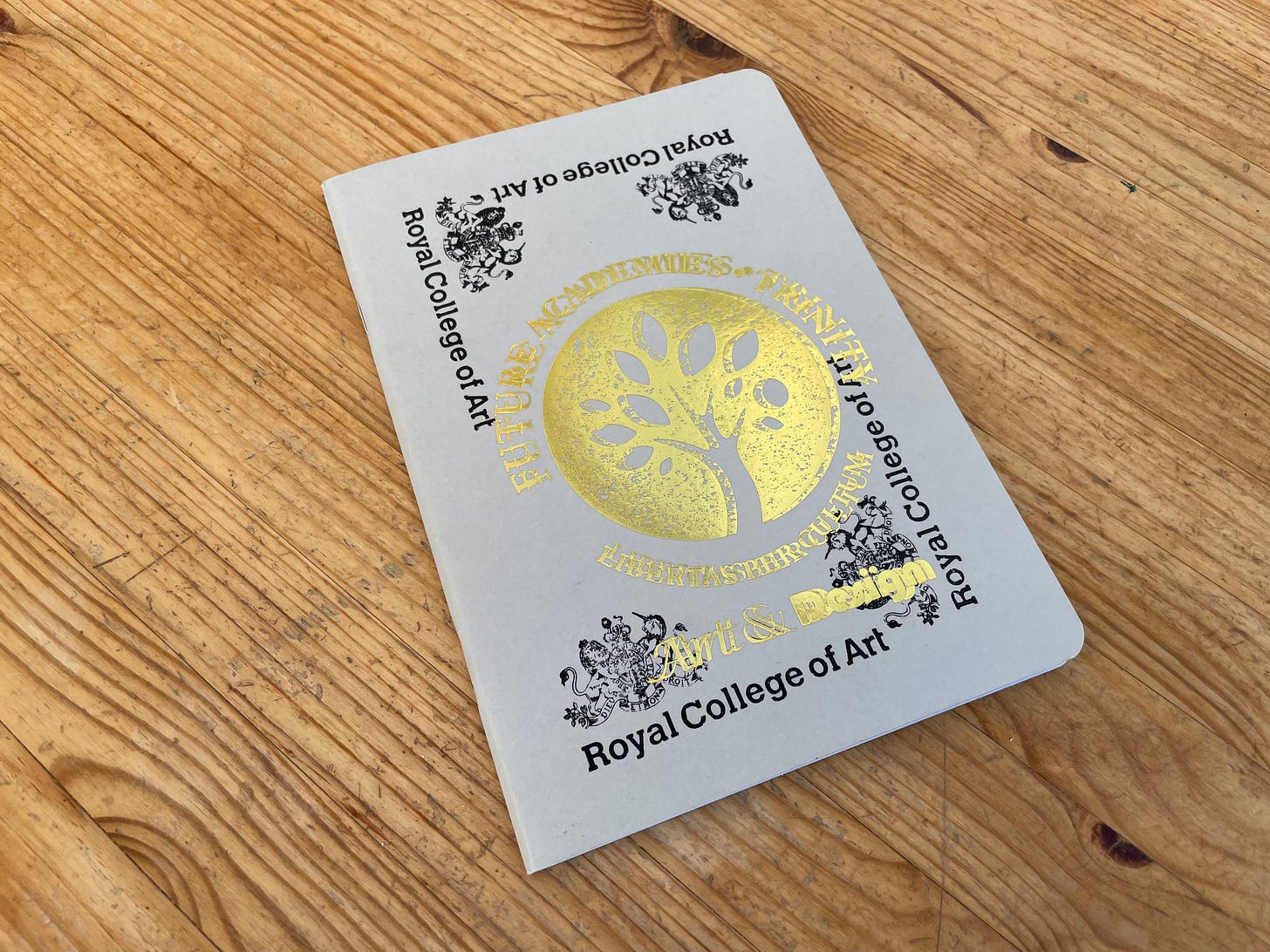
I promised him that I couldn’t wait to get started, but he still looked worried. ‘It’s not perfect, you know. It’s got a little scar on it from when I hid it in the tin.’
I had a look. ‘That scar is my sigh of relief!’ I told him. ‘It’s perfect because it’s not perfect.’ 😊
Spurred on by the recent course I’d taken on writing with constraints, I decided to adopt a constraint for working in my new book. It is this: to not create art in it.
And these are not strawberries – okay, they are strawberries, but I’m just playing with them with no intention of creating anything in particular. It’s not art: it’s a bit of fun splashed with strawberry juice.
Reader, this is creativity using dripping fruit, a chopping board, blotting paper, my fingers, the sunshine, cyanotype paper, paint, coloured pencils, a roller, scissors, gesso and glue. Anything goes!
I had picked up a punnet of local strawberries from the Village Stores – unusual specimens of their kind, each with a calyx2 vastly disproportionate to the size of the fruit itself.
Without feeling any pressure at all to make art, I had a look at the strawberries to get to know them. The ripest of them was leaking juice, and I thought I’d capture something of that.
Literally.
I smooshed the berry onto blotting paper to make pale pink puddles, then grabbed a cutting board and knife to slice another one in half, wondering if its juice would be dark enough to print its own innards.
Oooooh. This made me wonder whether I could print the beautifully-textured outside of the fruit. I squeezed some red paint onto a polythene bag, spread it out with the roller to transfer a thin layer to the rubber surface, and carefully applied it to one of the strawberries in order to try printing it onto both on paper and canvas.
The first print wasn’t terribly clear, but after a couple of transfers of paint from fruit to paper the berry had become a little softer, so it made better contact with the page. Some of the later prints were the result of a mixture of paint and juice – and yes, I was getting sticky!
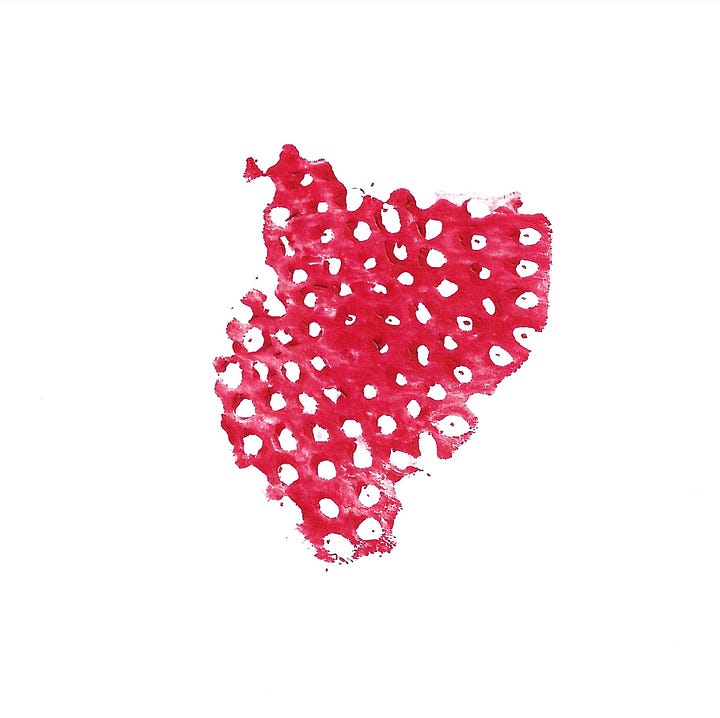
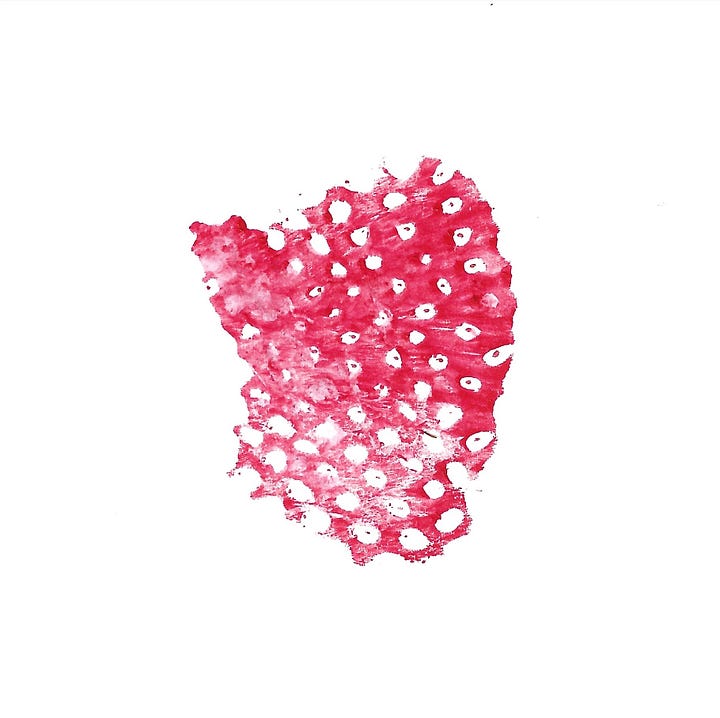
I left the juice-dampened book open to dry in the sunshine – which reminded me of the pack of cyanotype paper I’d been given last birthday. Could I make a sun print of a strawberry? 🤔
Sun print paper (also known as cyanotype paper, blueprint paper or heliographic printing paper) is sensitive to ultraviolet light, which is present in sunlight.
When exposed to sunlight, the light-sensitive emulsion in sun print paper reacts to form a blue-green image.
To use sun print paper, simply place the paper on a flat surface and arrange your objects on top of it. Then, expose the paper to sunlight for several minutes. The longer the paper is exposed to sunlight, the darker the print will be.
Once the paper has been exposed to sunlight, rinse it in water to develop the image. The paper will then be ready to dry and display.
Flatter items would work better than a whole strawberry, I thought, so I carefully removed the giant calyces from two of the strawberries to print, and also picked some leaves and a runner from a tiny wild strawberry plant at the edge of my garden.
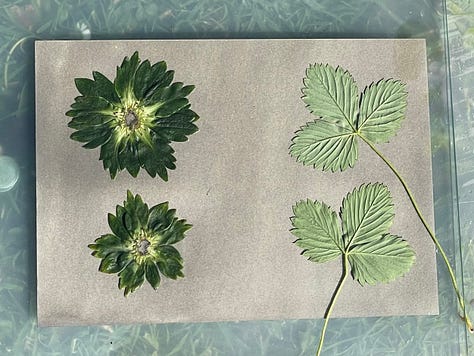
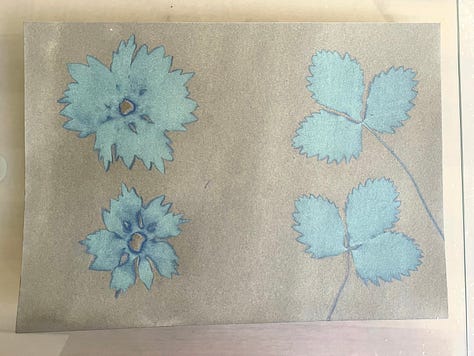
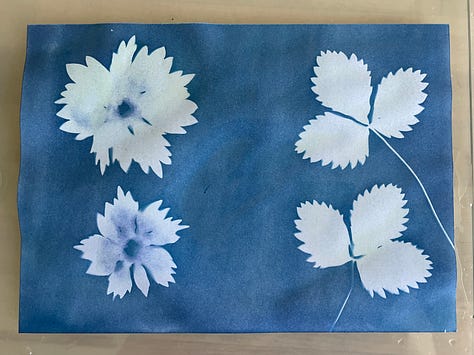
I made a sandwich of the 2D greenery on cyanotype paper between two sheets of glass, noticing too late that the strawberry runner had a tiny fruit attached. Squish!
I did want to see how a sun-printed strawberry from the Village Stores might look, though, even if didn’t work well, so I took a thin slice from the middle of it, calyx and all, and placed it on top of the top sheet of glass.3
I was intrigued by how the space taken up by the glass between the strawberry and the paper had influenced the print. The resulting image wasn’t of a strawberry at all, but a flying heart with its own shadow. ❤️
Cyanotypes washed and hung up to dry I took another look at one of the canvas pages on which I’d paint-printed some of the fruit, and the sunny strawberry slice above inspired me to have a little play with a red pen and some coloured pencils to turn the painty prints into messy stylised heart shapes. I’ve never worked on canvas before, and I was fascinated that its rough texture – aided and abetted by the layer of gesso I’d added to it – unexpectedly shredded my pencil tips into powdery pigment, which I then rubbed across the surface.
I found an enormous strawberry at the bottom of the punnet and used it for a second round of paint printing – this time onto a sheet of printer paper from the office – thinking I might cut out some shapes to make a collage. And hang on, if I was doing that, why shouldn’t I grab last weekend’s newspaper and find that article about strawberries? By adding a bit of colour to it I might be able to include the page in my collage.
I cut out simple shapes to represent the fruit, and for the calyces I dug out some painted paper from a previous project in shades of green.
You might remember these collages which have featured in previous Art & Treasures 🖼️ posts. In all three cases I had worked on top of the collage elements after they were stuck down, adding multiple layers of paint, pencil and watercolour crayon.
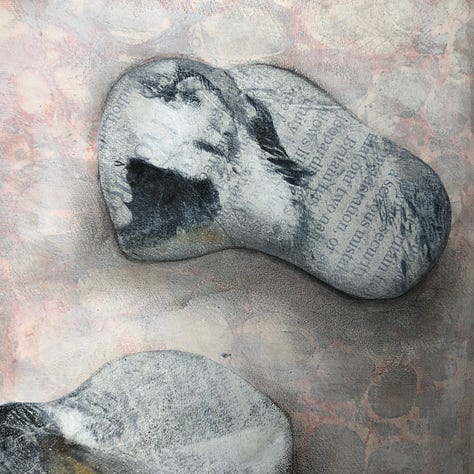
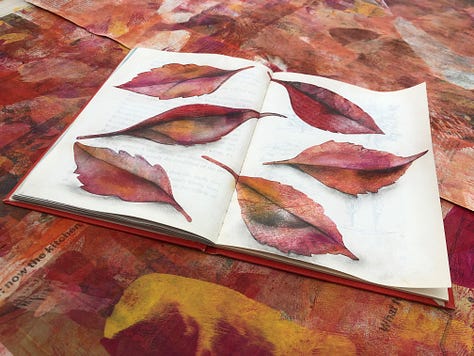
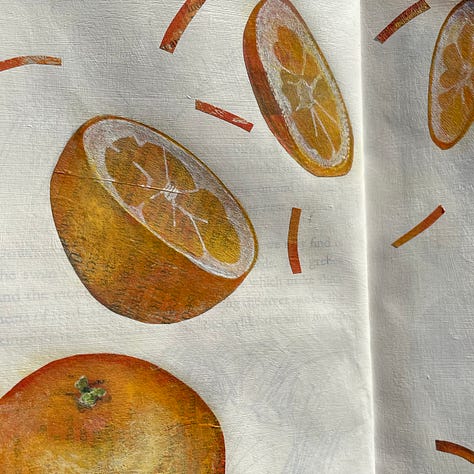
🍓
I used matte gel medium to adhere the strawberry collage elements to my primed pages, and painted the gel over them, too, pressing down with a damp cloth to give me a robust and stable surface to work on top of later.
‘Work’ on top of? ⛔️⚠️‼️✋
Hang on, this isn’t work, it’s playtime! No work has been done in the run-up to this post, and the creation of any art shown within it has been entirely unintentional!
And that’s why I’m leaving my gallery of strawberries just as it is.
Although I have taken huge pleasure in my fruity fiesta of fun, today’s jobs of work have not included layering orange, pink and pillar-box red onto my juicy collage pages, adding golden seeds to the surface of each fruit, going in with green pencils to make each calyx stand out from the page, nor fingerpainting bright white highlights onto the bulgiest bits of each berry.
I’m saving those tasks for a day on which I will be making intentional art.
Love,
Rebecca
STOP PRESS
Here’s a link to a follow-up post in which you can see the finished collage:
161. Going off piste
In which Rebecca considers the effect on her creativity of stepping sideways and how making art gives her writing time to breathe.
📚 Reading 📚
I am inspired by no end of posts about art and arting, and you’ll find links to just some of my favourite arty Substackers here:
📚
of📚
of📚
of . Susan’s running a challenge this weekend!📚
of📚
📚
of📚
📚 Regular readers of ‘Dear Reader, I’m Lost' will be no strangers to my ongoing light-hearted correspondence with fellow Brit
of . Terry illustrates his posts with his own art, too, and it’s his turn to reply to me next Wednesday!If you’ve enjoyed reading this post,please let me know by clicking the heart. Thank you! You’ll find all the posts in this ‘Art & Treasures’ series here.
Thank you for reading! If you enjoy ‘Dear Reader, I’m lost’, please share and subscribe for free.
Different areas in the world might have different lists, but here’s the list of UK anniversary names by year for the first fifteen years of marriage:
Paper
Cotton
Leather
Linen
Wood
Iron
Wool
Bronze
Pottery
Tin
Steel
Silk
Lace
Ivory
Crystal
The Strawberry Center page of Cal Poly’s website gives an excellent overview of the anatomy of the strawberry.
Actually the sheets of glass I used were two sliding doors from a little bookcase I have in my office. You can see a little round dent in each of them, which in fact are where I put my finger when I want to slide one of them open or closed.





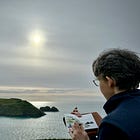
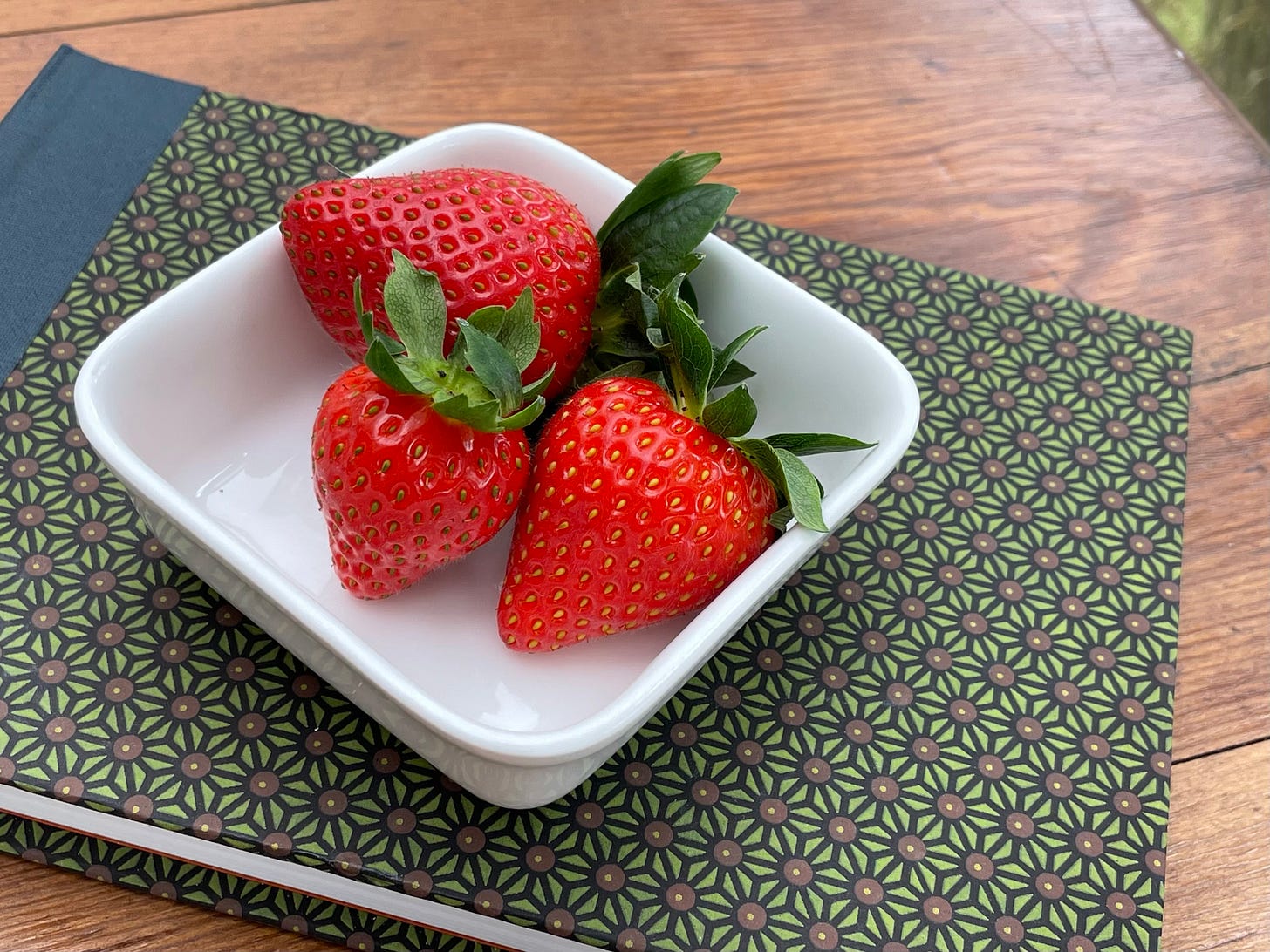
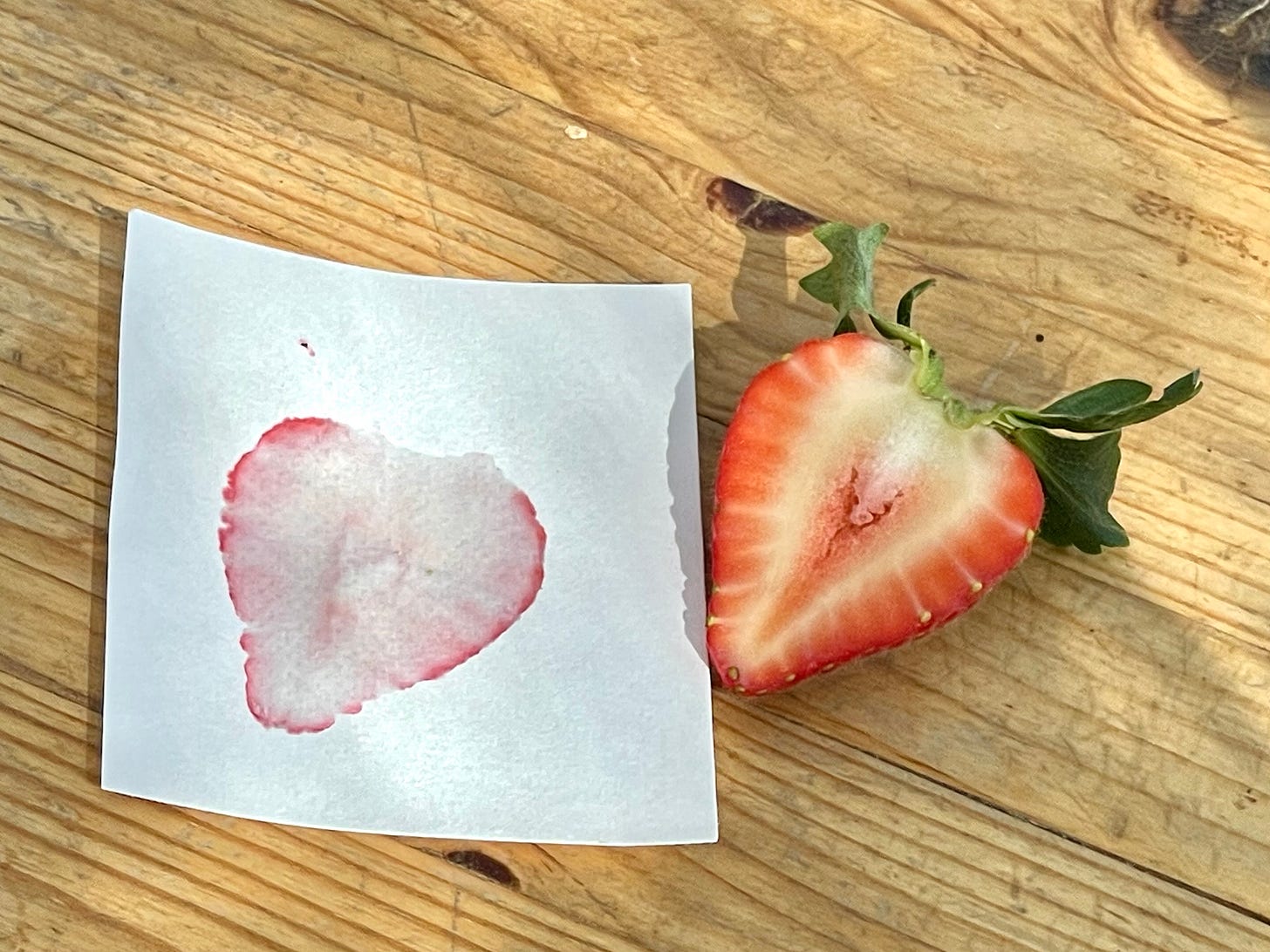
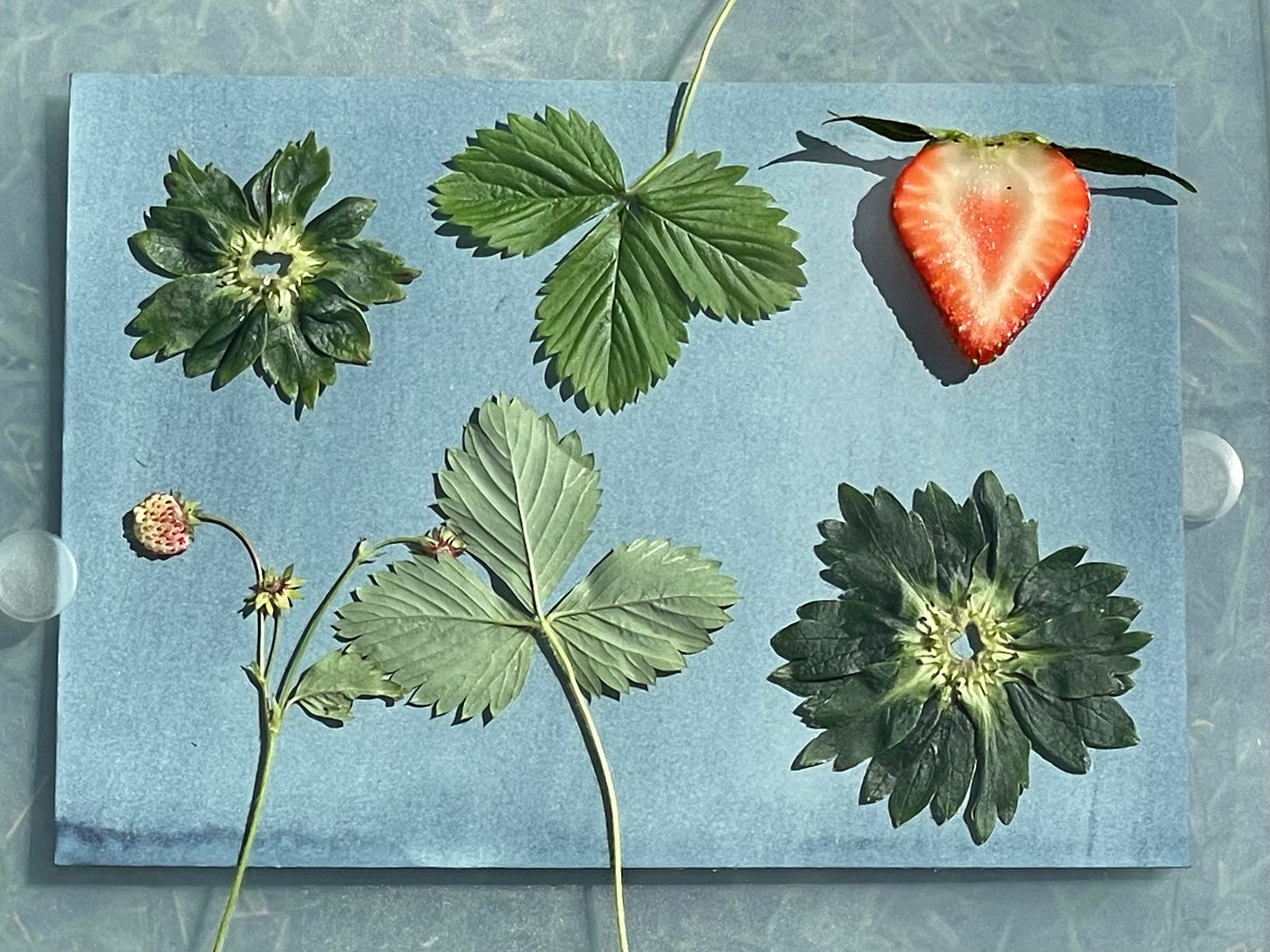
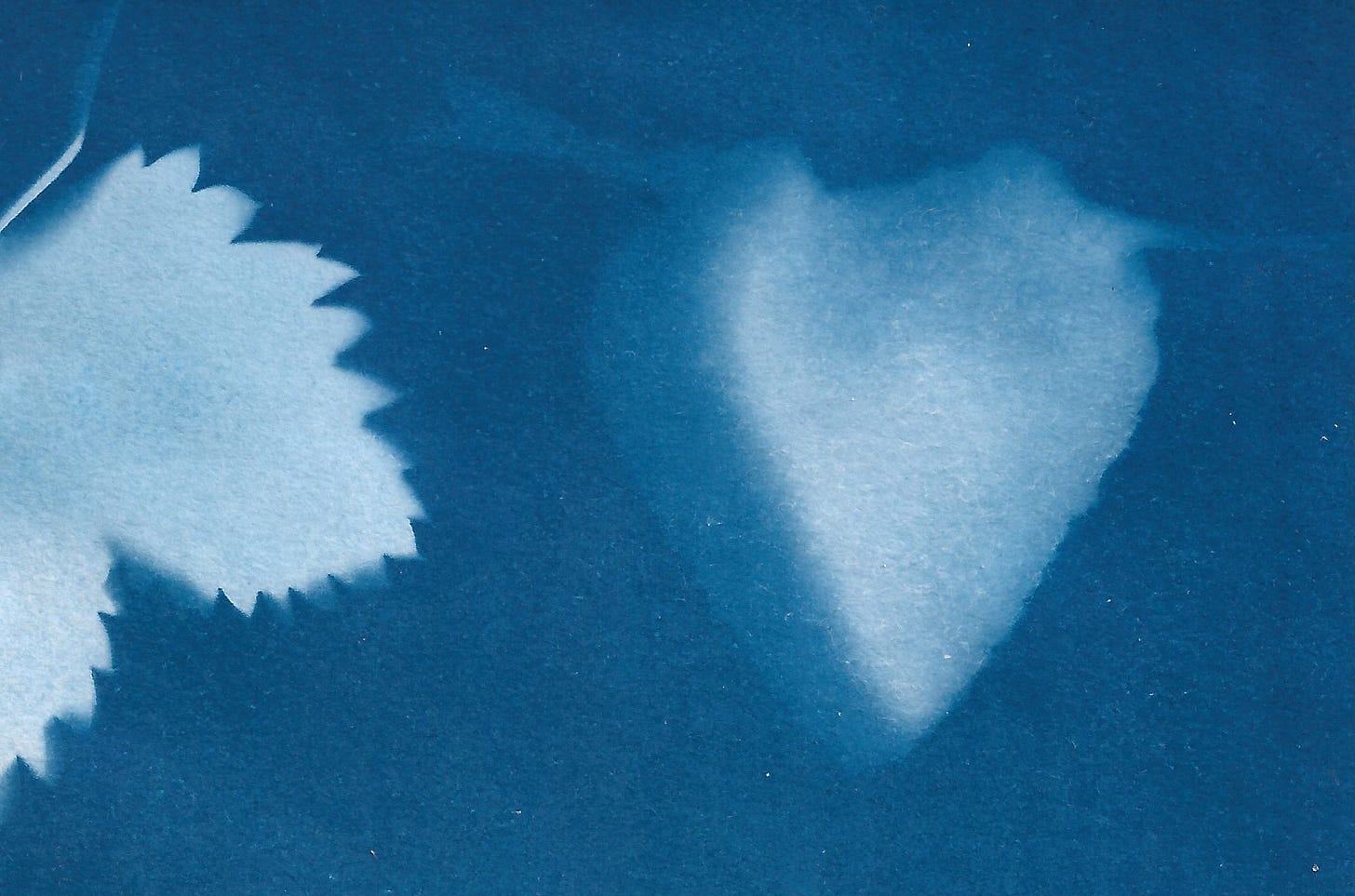

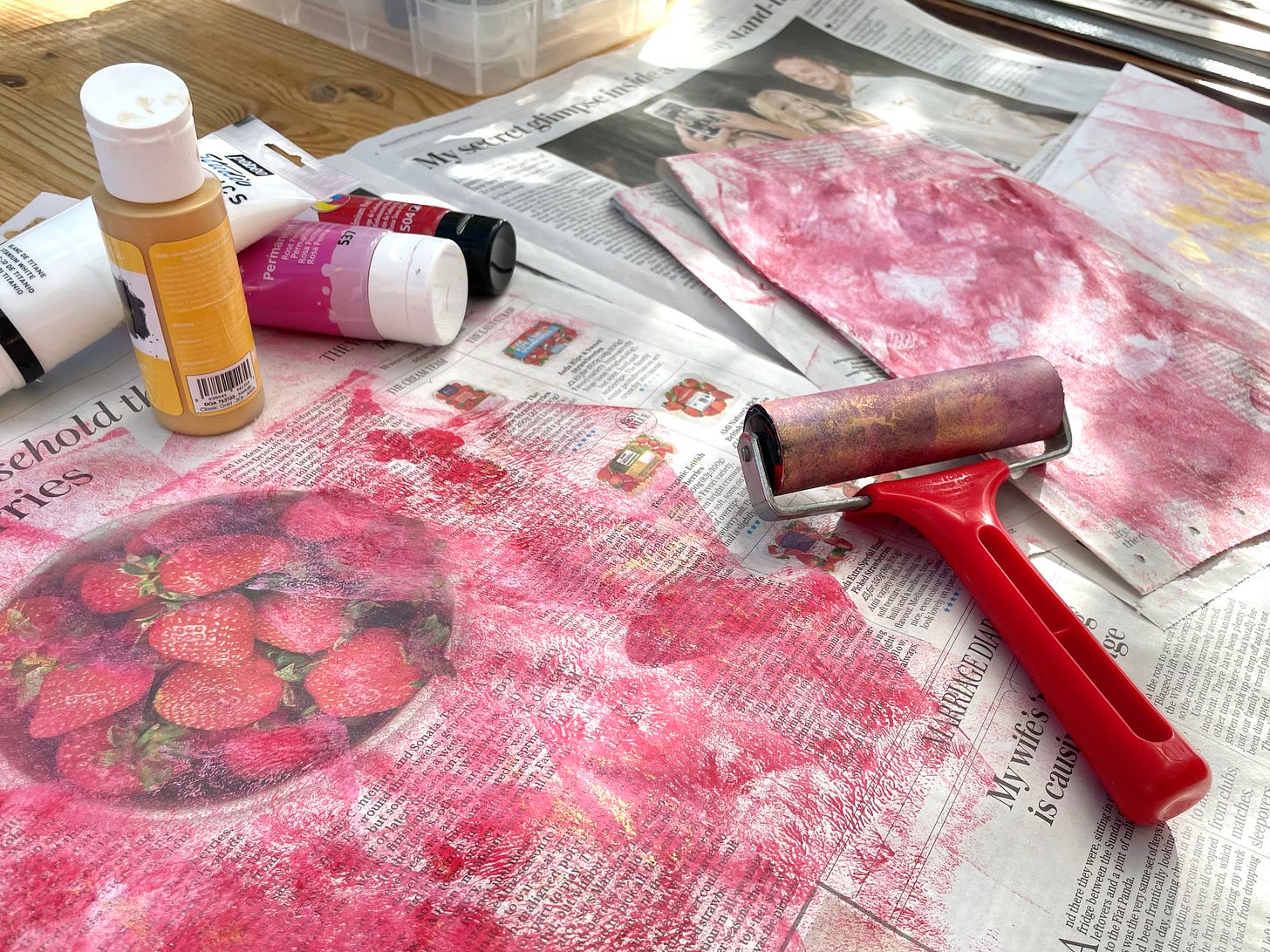
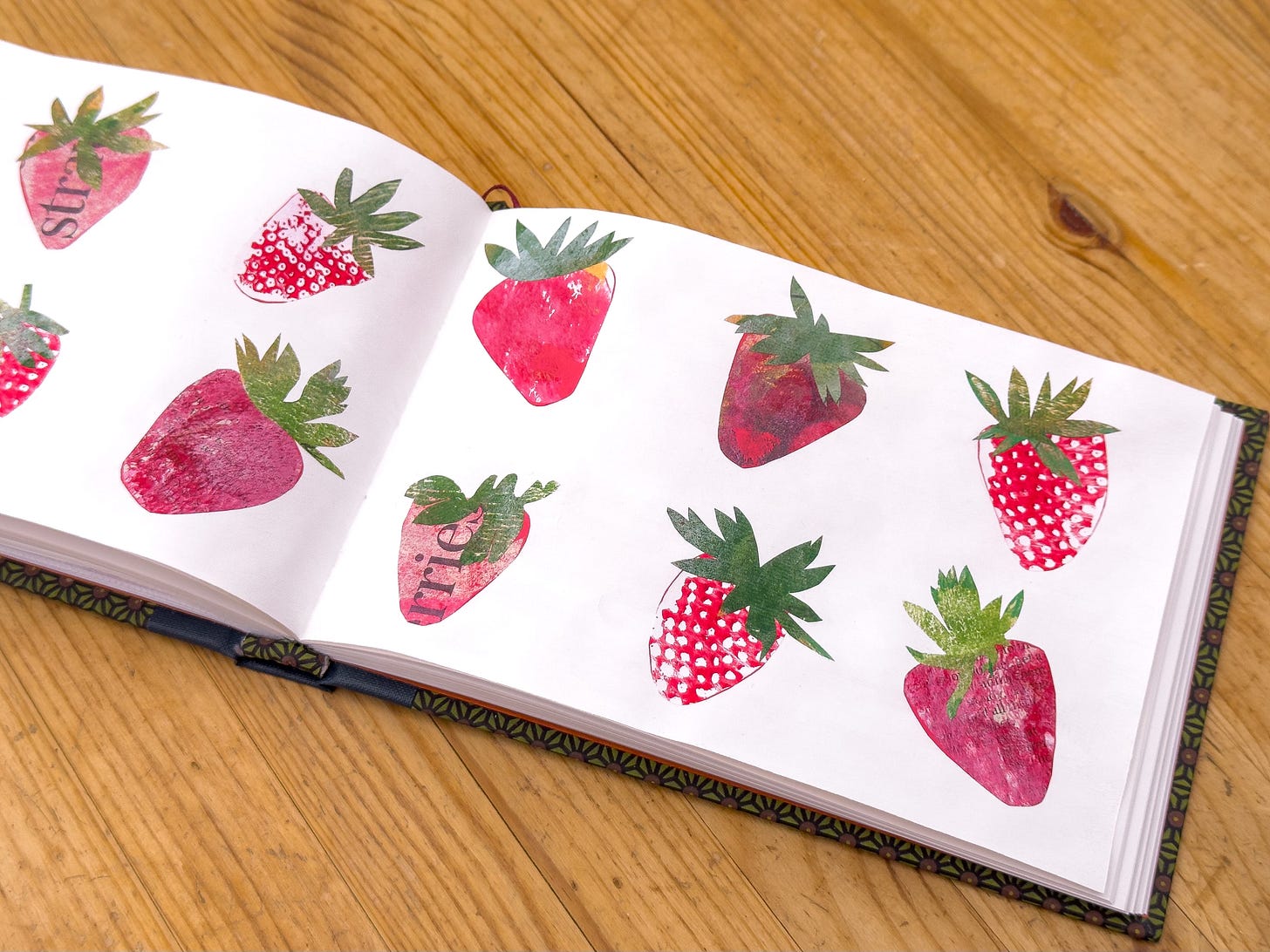
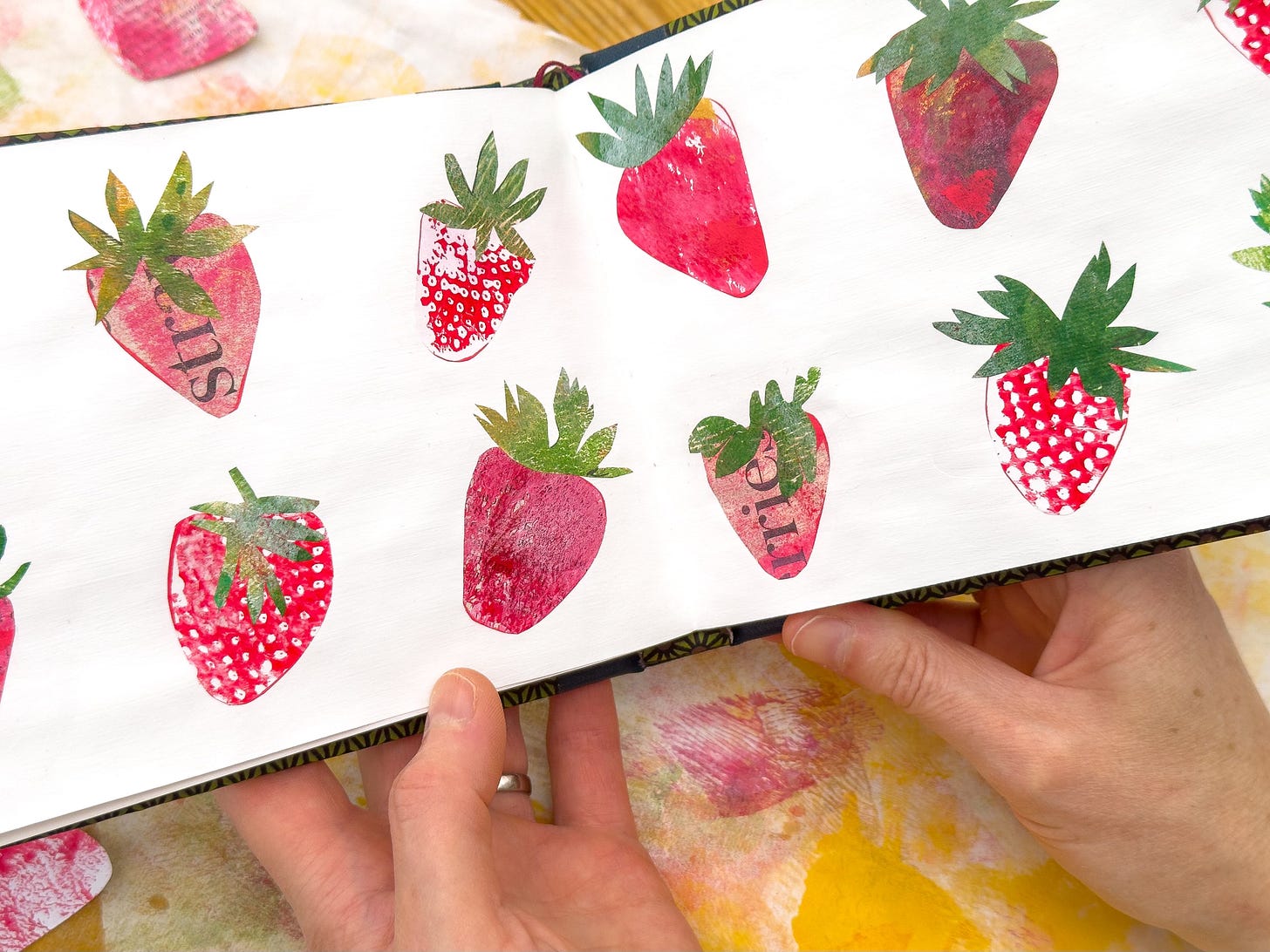
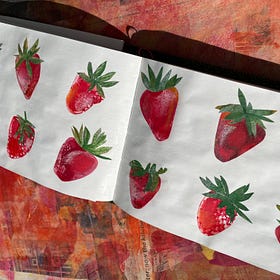

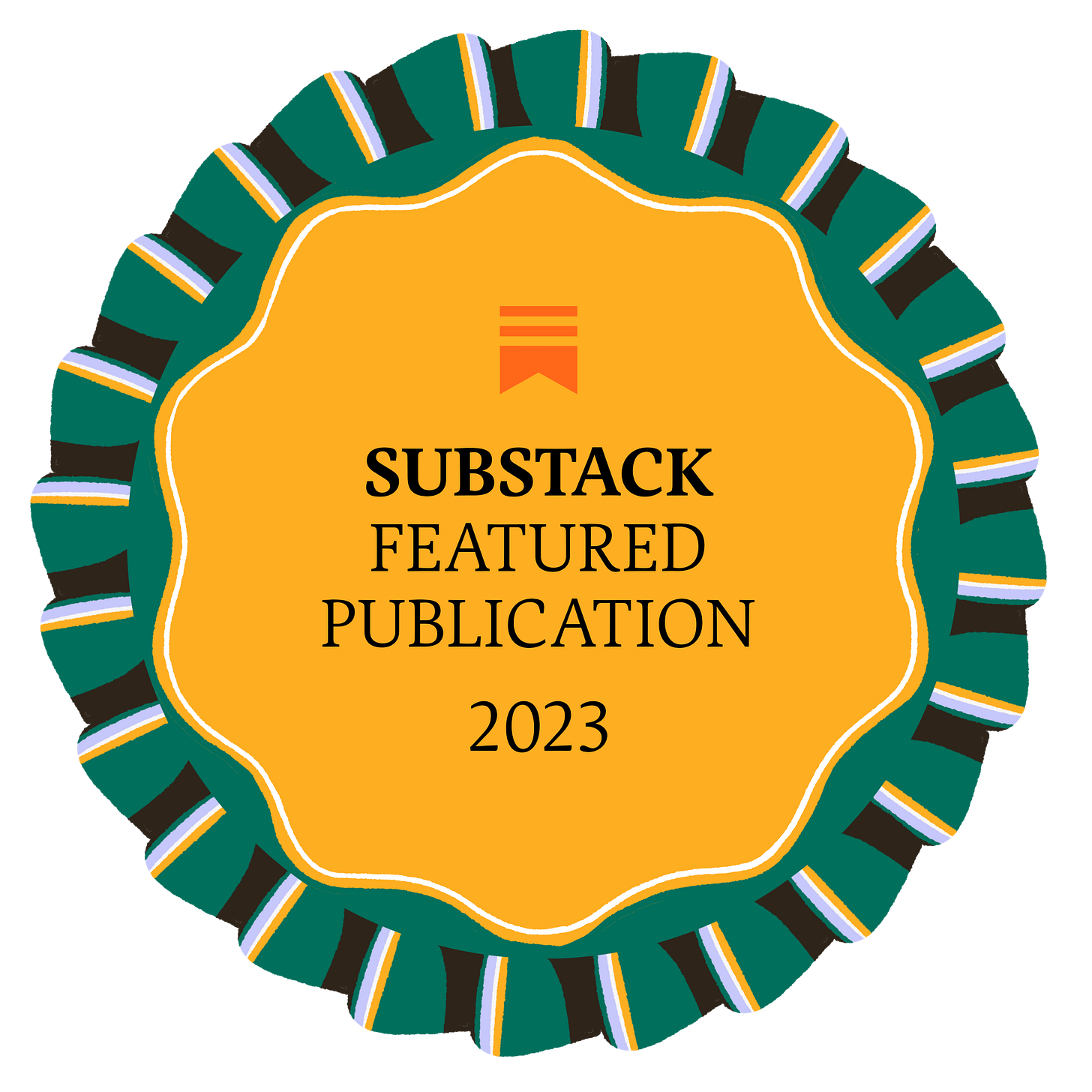
Bravo!!!! Bravo!!!! Hurrah!!!!! Hooray!!!! I absolutely love everything you did! You kept it simple, playful and fun!!! You started in the middle of your book too!!! And 3 cheers for the thoughtfulness your sweetheart put into your new book!!! Yippee!!! Keep going!!! Oh, and thanks for the mention!! 🍓🍓🍓🍓🍓🍓🍓🍓💚💚💚💚💚💚💚💚💚💚💚💚💚
And of course, your creativity ensured that pages 1, 2, 3, 4 etc are still available for future use. No starting at the beginning for Rebecca!! Which means you’ll never know what you’ll find as you leaf through. Brave, clever soul. (And something which may relate to the lack of map skills - your brain is non-linear!)
Lovely non-arting. Grin. Can’t use the word ‘work’, CAN use the word ‘play’. Delightful results, with so much additional potential for future ‘proper art’ sessions. Well done Jim. Well done Rebecca. ❤️💕